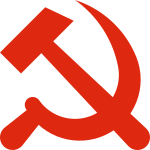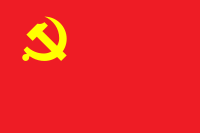| Emblem of the Chinese Communist Party | |
|---|---|
 | |
| Versions | |
 (1942–1996) | |
| Armiger | Chinese Communist Party |
| Adopted | 28 April 1942 |
 | |
| Use | Political flag |
|---|---|
| Proportion | 2:3 |
| Adopted | 21 September 1996 |
| Design | A red field with the party emblem at the canton. |
 (1942–1996) | |
| Use | Political flag |
| Proportion | 2:3 |
| Adopted | 28 April 1942 |
| Design | A red field with the party emblem at the canton. |
The emblem of the Chinese Communist Party is the hammer and sickle displayed in golden yellow or red. According to Article 53 of the constitution of the Chinese Communist Party, "the Party emblem and flag are the symbol and sign of the Communist Party of China." [1]
Contents
| Emblem of the Chinese Communist Party | |||||||
|---|---|---|---|---|---|---|---|
| Simplified Chinese | 中国共产党党徽 | ||||||
| Traditional Chinese | 中國共產黨黨徽 | ||||||
| |||||||
| Flag of the Chinese Communist Party | |||||||
|---|---|---|---|---|---|---|---|
| Simplified Chinese | 中国共产党党旗 | ||||||
| Traditional Chinese | 中國共產黨黨旗 | ||||||
| |||||||
